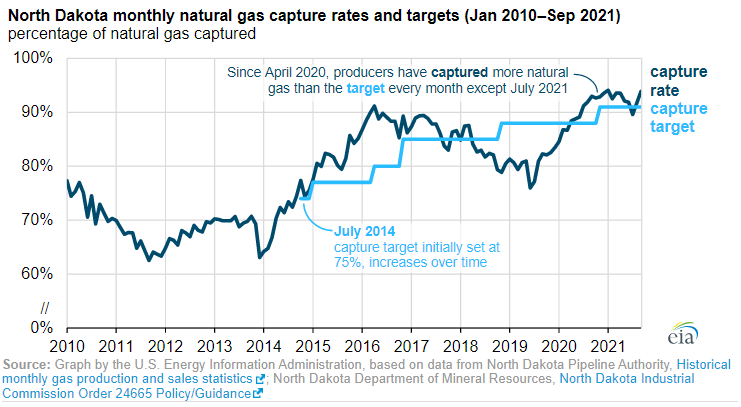North Dakota Exceeds Ambitious Flaring Reduction Targets in 2021
North Dakota natural gas producers met an ambitious natural gas capture target this year, capturing a whopping 92.5 percent of the natural gas produced, according to the Energy Information Administration. The goal set by the North Dakota Industrial Commission in 2020 was 91 percent.
In September – the most recent available data – nearly 94 percent of the natural gas produced was captured, even as production exceeded 3 billion cubic feet (bcf) per day.
As Ron Ness, president of the North Dakota Petroleum Council told EID:
“We are proud of the work and investment by the oil and gas industry to meet and exceed the state’s gas capture targets. This was a priority for our industry and we have made huge strides in reducing emissions while being able to provide the nation with reliable and affordable energy resources.”

Increased Infrastructure and Improved Technology Reduced North Dakota’s Flaring
Flaring in North Dakota has reached lows not seen since before 2008. This decrease occurred alongside significant increased production and demonstrates the industry’s commitment to improving production efficiency and reducing emissions.
North Dakota flared an average of 7.5 percent of natural gas for the year through September, which is down from an average of 19 percent in 2019 and more than 30 percent in 2013. These decreases were the result of increased pipeline takeaway capacity coupled with operators’ investments in new technology to better capture natural gas at the wellhead.
According to the EIA, the rapid growth in oil and gas development in North Dakota’s Bakken Shale initially outpaced the state’s ability to add pipeline takeaway capacity. Oil production in the state has nearly quadrupled since 2010, while natural gas production grew from 70 bcf to more than 718 bcf in 2020.

But alongside that growth in production, companies invested some $20 billion to reduce flaring in the Bakken and the results are noticeable, according to the head of the North Dakota Department of Mineral Resources. In addition, investment in new pipelines, including a planned expansion of the North Bakken pipeline that was announced in September, is helping to incentivize gas capture by providing producers a means of getting more natural gas to market.
As EIA explains:
“Meeting the capture targets required a buildout of natural gas gathering lines to transport natural gas from wells to processing plants and a buildout of the processing plants that remove impurities and heavier hydrocarbons from the natural gas. The North Dakota Industrial Commission reports that natural gas processing capacity in the state increased from 1 Bcf/d in 2013 to 3.4 Bcf/d in 2020, and they expect it to exceed 4.0 Bcf/d by the end of 2021.
“Expanded pipeline capacity to move natural gas plant liquids (NGPLs) out of the state has further improved North Dakota’s midstream infrastructure…According to our Liquids Pipeline Projects Database, the pipeline capacity to move NGPLs out of the North Dakota production region increased from 60,000 barrels per day (b/d) in 2013 to more than 580,000 b/d as of September 2021.”
The result: Only 5 percent of shale gas was flared this year and about 2.5 percent of associated gas. In other words, North Dakota is well on its way to ending routine flaring and drastically reducing its methane emissions, all while continuing to provide reliable energy, both domestically and globally.

No Comments